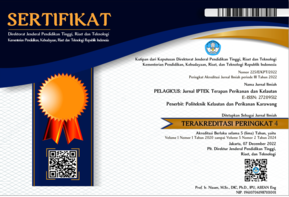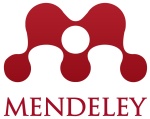Analysis of The Standard Quality of The Crude Solar Salt become The Health and Industry's Salt in Karawang District
Abstract
"Krosok" salt, or "Crude Solar Salt", is salt produced through the evaporation and crystallization of seawater. Some krosok salts have different qualities, and this is influenced by the quality of seawater as raw material, available production facilities and post-harvest handling. This krosok salt is mainly produced by salt farmers along the north coast of Karawang Regency. This study aimed to determine the quality of krosok salt obtained from salt farmers in Karawang Regency and to raise salt quality standards to increase the sale value of salt by creating healthy and industrial salt products. The method is to re-crystallize the "krosok" salt by adding binders or additives. Based on the results of the salt crystal test in the laboratory, it is known that the crystallization of "krosok" salt in Karawang Regency has a NaCl content of up to 99.35%; this value is already above the SNI quality standard of 98% as health salt. Meanwhile, for hazardous materials such as (Hg) and (As), the content is around 0.001%, below the SNI threshold of 0.1%.
Keywords
Full Text:
PDFReferences
Adibrata, S., Sari, F. I. P., Andriyadi, A., & Harto, B. (2021). Potensi Kualitatif Produksi Garam dari Perairan Pantai Lubuk dan Pantai Takari, Bangka Belitung. Buletin Oseanografi Marina, 10(1), 13–22. https://doi.org/10.14710/buloma.v10i1.31797
Dewanti, D. P., Arifudin, Adhi, R. P., Saraswati, A. A., Murti, S. D. S., & Prayitno, J. (2021). Kajian Lingkungan Pengembangan Produksi Garam Industri Di Indonesia. JRL, 14(2), 146–155.
Efendy, M., Sidik, R. F., & Triajie, H. (2013). Penggunaan Zat Aditif Ramsol dalam Meningkatkan Mutu Garam Rakyat. Jurnal Kelautan: Indonesian Journal of Marine Science and Technology, 6(1), 67–71. http://journal.trunojoyo.ac.id/jurnalkelautan/article/view/834
Hoiriyah, Y. U. (2019). Peningkatan Kualitas Produksi Garam Menggunakan Teknologi Geomembran. Jurnal Studi Manajemen Dan Bisnis, 6(2), 71–76. https://doi.org/10.21107/jsmb.v6i2.6684
Kementerian Perindustrian. (2020). Kebutuhan Garam Nasional. Direktorat Jenderal Industri Kimia, Farmasi, Dan Tekstil, April.
Kurniawan, A., Assafri, F., Munandar, M. A., Jaziri, A. A., & Guntur, G. (2019). Analysis of Sea Salt Quality From the Green House Prism Method in Sedayu Lawas Village, Lamongan Regency, East Java. Jurnal Kelautan Nasional, 14(2), 95–102. http://ejournal-balitbang.kkp.go.id/index.php/jkn/article/view/7073
Martina, A., Judy, I., Witono, R., & Sc, M. A. (2014). PEMURNIAN GARAM DENGAN METODE HIDROEKSTRAKSI BATCH Disusun Oleh : Lembaga Penelitian dan Pengabdian kepada Masyarakat Universitas Katolik Parahyangan.
Maulana, K. D., Jamil, M. M., Putra, P. E. M., Rohmawati, B., & Rahmawati. (2017). Peningkatan Kualitas Garam Bledug Kuwu Melalui Proses Rekristalisasi dengan Pengikat Pengotor CaO , Ba ( OH ) 2 , dan. Journal of Creativity Student, 2(1), 42–46.
Mustofa, & Turjono, E. (2015). Analisis Optimalisasi Terhadap Aktivitas Petani Garam Melalui Pendekatan Hulu Hilir Di Penambangan Probolinggo. Jurnal WIGA, 5(1), 46–57.
Nuzula, N. I., Sri, W., Pratiwi, W., Indriyawati, N., & Efendy, M. (2020). Analisa Komposisi Kimia pada Bittern (Studi kasus Tambak Garam Desa Pedelegan Pamekasan Madura). Prosiding Seminar Nasional Kahuripan 1, 4–7.
Prastio, L. O. (2019). Strategi Program Pemberdayaan Usaha Garam Rakyat Di Desa Muara Baru Kecamatan Cilamaya Wetan Kabupaten Karawang. The Indonesian Journal of Politics and Policy (Ijpp), 1(1), 62–73. https://doi.org/10.35706/ijpp.v1i1.1647
Santosa, I. (2014). PEMBUATAN GARAM MENGGUNAKAN KOLAM KEDAP AIR BERUKURAN SAMA Imam. Spektrum Industri, 12(1), 1–112.
Sumada, K., Dewati, R., & Suprihatin. (2016). Garam Industri Berbahan Baku Garam Krosok Dengan Metode Pencucian dan Evaporasi (Industrial Salt Made From Krosok Salt Using Washing and Evaporation Method). Jurnal Teknik Kimia, 11(1), 30–36. http://www.ejournal.upnjatim.ac.id/index.php/tekkim/article/view/827
Surya, A. R. P. (2018). Studi kelayakan garam indigenus grobogan sebagai bahan baku garam konsumsi beriodium menurut standar nasional. In Karya Tulis Ilmiah. Politeknik Kesehatan Bhakti Setya Indonesia Yogyakarta.
Tansil, Y., Kimia, T., & Industri, F. T. (2016). Produksi Garam Farmasi dari Garam Rakyat. 5(2), 0–4.
Umam, F. (2019). Pemurnian Garam dengan Metode Rekristalisasi di Desa Bunder Pamekasan untuk Mencapai SNI Garam Dapur. 5(1).
Wibowo, A. (2020). Potensi Pengembangan Standar Nasional Indonesia ( SNI ) Produk Garam Konsumsi Beryodium Dalam Rangka Meningkatkan Daya Saing. 79–88.
DOI: http://dx.doi.org/10.15578/plgc.v3i3.11336
Refbacks
- There are currently no refbacks.

This work is licensed under a Creative Commons Attribution-ShareAlike 4.0 International License.
E-ISSN: 2720-9512
ISSN: 2715-9620












